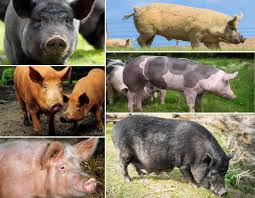There are over 90 recognized breeds of pigs in the world. They can be broadly classified into indigenous or unimproved types or the more modern exotic types which have been selected and developed for specific commercial purposes.
1. Indigenous Breeds of Pigs (Unimproved)
These are mostly found in developing countries and have evolved a variety of shapes and sizes in order to survive in a range of environments. Generally, they have smaller and shorter leg than the exotic types.
Mature weight of females ranges between 40 – 120 kg, with the typical unimproved conformation of a large head, well- developed forequarters and relatively light hindquarters.
This renders them more mobile and better able to forage and root for themselves. They mature sexually early and females may show first oestrus as early as three months of age.
There are many variations of coat colour, but black and brown are most common and white is infrequent. The degree of hairiness also varies, and both hairless and relatively long–haired types are found. Bakosi in the Cameroons and the Ashanti Dwarf in Ghana are examples of indigenous breeds.
Their characteristics include small body with mature female size of 40-60kg, and are mainly black in colour with prick ears.
The unimproved pigs of East, Central and Southern Africa are mostly descended from stock introduced by early European travelers, and therefore not truly indigenous, they are relatively wide spread.
The productivity of these unimproved breeds in Africa is influenced by their environment and some typical reproductive performance.
The litter size of the indigenous breeds tends to be smaller than improved breeds, but total live weight of the litter as a proportion of the weight of the sow at farrowing was similar to that of the exotic sows.
2. Exotic Breeds in the Tropics
1. Duroc
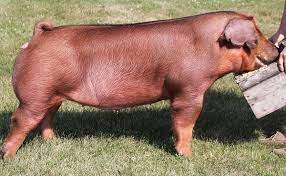
This has droppy ears and is deep red or rusty colour. It is a fast growing large breed. The Duroc produces a very good carcass and is said to be an excellent meat producer.
Also it has the ability to grow to heavier weights without depositing too much fat. The Duroc is a hardy animal which survives well in tropical climate. It is generally used for cross- breeding.
2. Large White (Yorkshire)
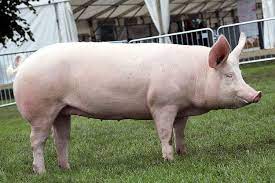
This breed was first developed in Yorkshire, England. It has erect ears and is white in colour and females are prolific. It is renowned for its strength of leg.
The breed can be used for both pork and bacon production. It is a fairly hardy animal but will suffer from sun-burn if it is not kept in a building out of the sun.
Read Also : Advantages and Disadvantages of Pig Farming
3. Landrace
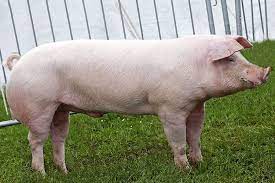
It is characterized by its forward-pointing lop ears and possesses a long, smooth body with light shoulders and well developed hams.
It is white in colour, this swine is good for bacon production, but has a higher level of susceptibility to stress and requires a high level of management.
4. Hampshire
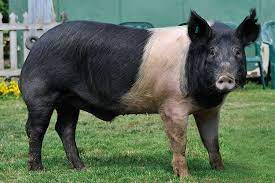
This swine is black with distinct white saddle which encircles the forequarter. They are prolific, good mothers, and have good milking ability.
It has more meat than the large white and landrace. It is probably best kept for cross breeding.
5. Tamworth
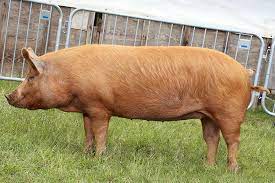
This hardy animal is reddish in colour and with erect ears. It is an efficient converter of feed. The breed is relatively slow-maturing. In the past, it has been very popular for cross-breeding purposes in tropical regions.
In summary, there are over 90 recognized breeds and an estimated 230 varieties of pigs in the world. They can be broadly classified into indigenous or unimproved types or the more modern exotic types which have been selected and developed for specific commercial purposes. The basic features of the different breeds ere also discussed.
Read Also : Household Hazardous Waste (HHW)

